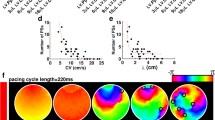Abstract
In recent years it has become evident that myocardial tissue undergoes remodeling in diseased states such as myocardial infarction and hypertrophy which affects membrane channels, cell-to-cell coupling as well as the connective tissue matrix. Although the detailed mechanisms of ventricular arrhythmias in ventricular hypertrophy are not known, studies carried, out by computer simulations or high resolution mapping of electrical activity have suggested a complex interaction between changing ionic currents at the level of the cell membranes, altered cell-to-cell coupling and altered macroscopic structure. The present report summarises these recent developments and their potential relevance for arrhythmogenesis.
Similar content being viewed by others
References
Janse M, Wit A (1989) Electrophysiological mechanisms of ventricular arrhythmias resulting from ischemia and infarction. Physiological Reviews 69: 1049–1169
Allessie MA, Bonke FIM, Schopman FJC (1977) Circus movement in rabbit atrial muscle as a mechanism of tachycardia. III. The “leading circle” concept: a new model of circus movement in cardiac tissue without the involvement of an anatomical obstacle. Circ Res 41: 9–18
January CT, Riddle JM (1989) Early afterdepolarizations: mechanism of induction and block. A role for L-type Ca2+ current. Circ Res 64: 977–990
Luo CH, Rudy Y (1994) A dynamic model of the cardiac ventricular action potential. II. afterdepolarizations, triggered activity, and potentiation. Circ Res 74: 1097–1113
Jalife J, Moe GK (1981) Excitation, conduction, and reflection of impulses in isolated bovine and canine cardiac Purkinje fibers. Circ Res 49: 233–247
Wit AL, Cranefield PF, Hoffman BF (1972) Slow conduction and reentry in the ventricular conducting system. II. Single and sustained circus movement in networks of canine and bovine Purkinje fibers. Circ Res 30: 11–22
Janse MJ, Van Capelle FJL, Freud GE, Durrer D (1971) Circus movement within the AV node as a basis for supraventricular tachycardia as shown by multiple microelectrode recording in the isolated rabbit heart. Circ Res 28: 403–414
Antzelevitch C, Bernstein MJ, Feldman HN, Moe GK (1983) Parsystole, reentry, and tachycardia: a canine preparation of cardiac arrhythmias occurring across inexcitable segments of tissue. Circulation 68: 1101–1115
Spach MS, Heidlage JF (1995) The stochastic nature of cardiac propagation at a microscopic level-electrical description of myocardial architecture and its application to conduction. Circ Res 76: 366–380
Leon LJ, Roberge FA (1991) Directional characteristics of action potential propagation in cardiac muscle. A model study. Circ Res 69: 378–395
Rohr S, Salzberg BM (1994) Multiple site optical recording of transmembrane voltage (MSORTV) in patterned growth heart cell cultures: assessing electrical behavior, with microsecond resolution, on a cellular and subcellular scale. Biophys J 67: 1301–1315
Fast VG, Kleber AG (1993) Microscopic conduction in cultured strands of neonatal rat heart cells measured with voltage-sensitive dyes. Circ Res 73: 914–925
Mines G (1913) On the dynamic equilibrium of the heart. J Physiol (London) 46: 349–383
Boyden P, Jeck C (1995) Ion channel function in disease. Cardiovasc Res 29: 312–318
Fast VG, Pertsov AM (1990) Drift of a vortex in the myocardium. Biophysics 35: 489–494
Spach MS, Josephson ME (1994) Initiating reentry: The role of nonuniform anisotropy in small circuits. J Cardiovasc Electrophysiol 5: 182–209
Dillon SM, Allessie MA, Ursell PC, Wit AL (1988) Influences of anisotropic tissue structure on reentrant circuits in the epicardial border zone of subacute canine infarcts. Circ Res 63: 182–206
De Bakker JMT, Van Capelle FJL, Janse MJ, Tasseron S, Vermeulen JT, Dejonge N, Lahpor JR (1993) Slow conduction in the infarcted human heart —zigzag course of activation. Circulation 88: 915–926
De Bakker JMT, Van Capelle FJL, Janse MJ, Vanhemel NM, Hauer RNW, Defauw JJAM, Vermeulen FEE, Dewekker PFAB (1991) Macroreentry in the infarcted human heart — the mechanism of ventricular tachycardias with a focal activation pattern. J Am Coll Cardiol 18: 1005–1014
Rohr S, Schölly DM, Kleber AG (1991) Patterned growth of neonatal rat heart cells in culture. Morphological and electrophysiological characterization. Circ Res 68: 114–130
Delmar M, Michaels DC, Johnson T, Jalife J (1987) Effects of increasing intercellular resistance on transverse and Iongitudinal propagation in sheep epicardial muscle. Circ Res 60: 780–785
Kadish AH, Spear JF, Levine JH, Moore EN (1986) The effects of procainamide on conduction in anisotropic canine ventricular myocardium. Circulation 74: 616–625
Tsuboi N, Kodama I, Tayama J, Yamada K (1985) Anisotropic conduction properties of canine ventricular muscles. Jpn Circ J 49: 487–498
Spach MS, Miller WTI, Gezelowitz DB Barr RC, Kootsey JM, Johnson EA (1981) The discontinuous nature of propagation in normal canine cardiac muscle. Evidence for recurrent discontinuities of intracellular resistance that affect the membrane currents. Circ Res 48: 39–54
Fast VG, Kleber AG (1994) Anisotropic conduction in monolayers of neonatal rat heart cells cultured on collagen substrate. Circ Res 75: 591–595
Fast VG, Kleber AG (1994) Conduction velocity and shape of action potential upstroke in a computer model of an anisotropic heart cell monolayer. Circulation 90: I-40
Sommer JR, Scherer B (1985) Geometry of cell and bundle appositions in cardiac muscle: light microscopy. Am J Physiol 248: H792-H803
Fast VG, Kleber AG (1995) Cardiac tissue geometry as a determinant of unidirectional conduction block: assessment of microscopic excitation spread by optical mapping in patterned cell cultures and in a computer model. Cardiovasc Res 29: 697–707
Cabo C, Pertsov AM, Baxter WT, Davidenko JM, Gray RA, Jalife J (1994) Wave-front curvature as a cause of slow conduction and block in isolated cardiac muscle. Circ Res 75: 1014–1028
Spach MS, Dolber PC (1986) Relating extracellular potentials and their derivatives to anisotropic propagation at a microscopic level in human cardiac muscle. Evidence for electrical uncoupling of side-to-side fiber connections with increasing age. Circ Res 58: 356–371
Fast VG, Kleber AG (1995) Block of impulse propagation at an abrupt tissue expansion: evaluation of the critical strand diameter in 2- and 3-dimensional computer models. Cardiovasc Res 30: 449–459
Author information
Authors and Affiliations
Rights and permissions
About this article
Cite this article
Kleber, A.G., Fast, V. Molecular and cellular aspects of re-entrant arrhythmias. Basic Res Cardiol 92 (Suppl 1), 111–119 (1997). https://doi.org/10.1007/BF00794075
Issue Date:
DOI: https://doi.org/10.1007/BF00794075




